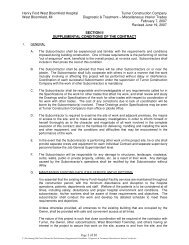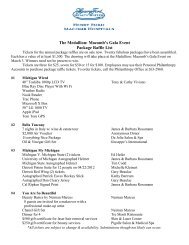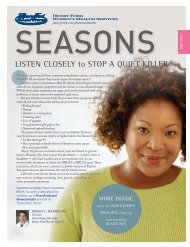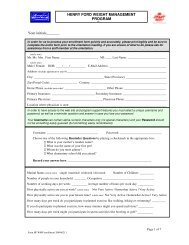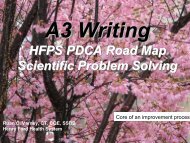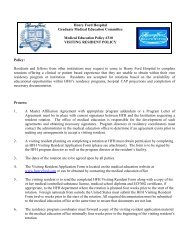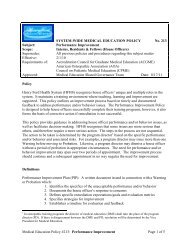Syncope with Jaundice
Choledochal Cyst.pdf - Henry Ford Health System
Choledochal Cyst.pdf - Henry Ford Health System
You also want an ePaper? Increase the reach of your titles
YUMPU automatically turns print PDFs into web optimized ePapers that Google loves.
Department of Radiology<br />
Henry Ford Health System<br />
Detroit, Michigan<br />
<strong>Syncope</strong> <strong>with</strong> <strong>Jaundice</strong><br />
Nena A. Stanley, MS IV<br />
Wayne State University School of Medicine<br />
December 19, 2008
History<br />
HPI: 83<br />
83 yo male <strong>with</strong> a PMH dementia, DMII, HTN, atrial fibrillation<br />
presented to ER after episode of syncope. Pt. stated he became<br />
dizzy in the bathroom and lost consciousness. Patient stated had<br />
experienced one past episode of syncope two weeks prior which<br />
he sought no treatment. Associated symptoms (+)loss<br />
incontinence (+)clay-colored colored stool, (+) coluria,<br />
, (+)dizziness,<br />
(+)jaundice, (+)HA, (+)30 lb wt loss, (-)fever,(<br />
chills, nt. sweats, (-(<br />
)recent head trauma, (-)nausea,(<br />
(-)vomiting,(<br />
(-)blurred(<br />
vision, (-(<br />
)tinnitus, (-)palpitations,(<br />
(-)dyspnea(<br />
on exertion, (-)orthopnea(<br />
orthopnea, , (-(<br />
)edema, (-)SOB,(<br />
(-)hemoptysis(<br />
hemoptysis, , (-)loss(<br />
of appetite, (-(<br />
)melena,, (-)hemetemesis(<br />
hemetemesis, , (-)hematuria(<br />
hematuria, , (-)dysuria(<br />
dysuria, , (-)(<br />
anemia, (-)numbness/tingling(<br />
of extremities
History continued<br />
PMH/PSH: : Dementia, DMII, HTN, a-fib, a<br />
MI, mitral valve replacement<br />
FH:<br />
Noncontributory<br />
SH: Married <strong>with</strong> 3 adult children, lives at home, (-)smoking,(<br />
(-)EtOH,, (-)recent(<br />
travel, (-)illegal(<br />
drug use<br />
MEDS: Coumadin, Digitoxin, Humulin (70/30), Motrin<br />
ALL:<br />
NKDA<br />
ROS:<br />
Per HPI<br />
PE:<br />
Gen: Oriented, A&Ox3, NAD<br />
HEENT: EOMI, PERRLA<br />
Cardio: RRR, S1/S2 (-)mrg(<br />
Resp: : Lungs CTA bilaterally<br />
Abd: : Soft NT, (-)masses,(<br />
)masses, (+)BS<br />
Rectal: (-)FOBT(<br />
Ext. (-)skin(<br />
excoriation, (-)bruising(<br />
Neurological: CN II-XI grossly intact
History continued<br />
• Labs: INR 6.45, elevated liver enzymes<br />
(SGOT: 498.0 U/L; SGPT:306 U/L; T.Billi<br />
22.2 mg/dl; Bili D 11.6 mg/dl; Alk Phos:<br />
1,281 U/L)<br />
• A/P<br />
• Abdominal US to rule out obstructive jaundice
Findings<br />
• Ultrasound <strong>with</strong> Doppler<br />
• Intrahepatic duct and common bile duct<br />
dilation<br />
• Slightly distended gallbladder <strong>with</strong> visible<br />
sludge<br />
• Unable to visualize pancreas<br />
• CT of abdomen recommended to visualize<br />
pancreas and further evaluation of biliary<br />
ducts
• CT of Abdomen<br />
Findings continued<br />
• Nodular intrahepatic biliary dilation greater in left<br />
hepatic lobe<br />
• Diffuse fusiform dilation of the common hepatic<br />
and bile duct measuring up to 3.9 cm<br />
• Findings compatible to type Iva choledochal cysts<br />
• No pancreatic cyst<br />
• ERCP and/or MRCP recommended to exclude an<br />
underlying biliary or ampullary lesion
• ERCP<br />
Findings continued<br />
• Significant intra and extrahepatic duct dilation<br />
• Recognized stricture <strong>with</strong>in the mid-common<br />
bile duct
Differential Diagnosis<br />
• Hepatic Cysts<br />
• Choledochal Cysts<br />
• Cholangiocarcinoma<br />
• Choledocholithiasis<br />
• Cholangitis<br />
• Duplicated Gallbladder
• Choledochal Cysts<br />
Diagnosis
Discussion<br />
• Classification<br />
• Type I is the most common and is a dilation of the common bile ductd<br />
• Type II is the rarest and is a diverticulum of the extrahepatic bile duct<br />
proximal to duodenum<br />
• Type III is a choledochal from embryological origin and cystic dilation of<br />
intraduodenal portion of the distal common bile duct<br />
• Type A bile duct and pancreatic duct converge on the cysts<br />
• Type B is diverticulum of the intraduodenal bile duct or common bile duct<br />
• Type IV multiple cysts<br />
• Type IVA multiple intra and extrahepatic cysts<br />
• Type IVB multiple extrahepatic parenchyma<br />
• Type V multiple cysts limited to intrahepatic parenchyma
• Frequency<br />
Discussion continued<br />
• Rare in U.S.<br />
• More prevalent in Asia<br />
• Mortality/Morbidity<br />
• Age dependent<br />
• Cholangiocarinoma malignancy 9-28% 9<br />
• Sex<br />
• Female prevalance 3:1
Discussion continued<br />
• Management/Treatment<br />
• Stent placement to correct stricture <strong>with</strong>in the<br />
mid-common bile duct<br />
• Surgical excision of cysts and resection of<br />
common biliary tract and duodenum<br />
• Biopsy of cystic tissue to evaluate for<br />
dysplastic changes
References<br />
DeGroen, Piet C., Biliary Tract Cancers, NEJM,<br />
1999, Vol 341, No. 18 1368-1377<br />
1377<br />
Novelline, , Robert A. Novelline, Squires’s<br />
Fundamentals of Radiology, 6 th Ed., Harvard<br />
University Press, Cambridge, MA: 2004<br />
Sawyer, Michael AJ, Choledochal Cyst, e-e<br />
medicine: April 13, 2007<br />
Topazian, , Mark, Biliary Cysts, Up to Date, v. 16.3:<br />
Oct. 1, 2008




